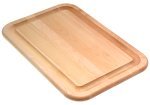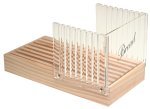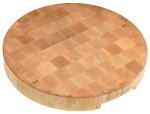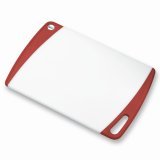
It will help you to select your cutting boards if you can first prepare answers to questions such as these…
1. How much space do you have on the kitchen countertop?
If you want a large cutting board (for example, 19 to 13 inches (48 to 33 cm)), you must have a place to put it on the countertop. You may also wish to leave the board there after use. Do you have enough free space?
2. How often, and for what purpose, are you going to use the cutting board?
If you are going to use it mainly for little cutting tasks or to serve small amounts of food, there is no point in having a large cutting board. However, if you are going to cut or chop foods such as raw meat, poultry, fish, etc., a larger board will be more comfortable for you because you will feel more at ease. In addition, a large board is good when serving a greater amount of food, for example a combination of different ingredients like cheese, vegetables, roasted meat, bread, etc.
3. Will you be able to wash the cutting board easily in the sink?
To wash the board thoroughly and easily, you need to be able to put it into the sink to a certain extent.
Characteristics of kitchen cutting boards
Cutting boards may be rectangular, square, round, oval, and with pleasantly-shaped edges for a better look when serving with them on the table.
Some boards have a rough undersurface, or feet on the underside. Thus the board won’t slip while you use it. The disadvantage here is that you can’t use both sides of the board.
Some boards are especially suitable for cutting raw meat (in addition to all the other ingredients, of course). They have grooves on one or both surfaces, whose purpose is to trap the juices of the foods you cut. In addition to the juices not staining the countertop or table, you can use them for the sauce of the meal you are preparing.

Other boards are suitable mainly for cutting bread, as they are usually boards with slats on a removable tray. When you cut bread, the crumbs fall between the board slats on this tray, without being scattered on the countertop, the table or the floor. Some boards have also guides for cutting slices of the same size.

Yet more boards are designed to fit over the sink. They are ideal in case your kitchen is small and you don’t have enough space on the countertop. Some of these boards have a small colander by one of the ends to wash/rinse the foods you cut, or a bin for the cut ingredients.

Some of kitchen cutting boards come in a package from several boards with different sizes; enough to meet most of your needs for cutting or serving.
Types of kitchen cutting boards
Boards may be divided into two basic types…
- wood cutting boards
- plastic cutting boards
Wood cutting boards
Wood boards are made from hardwood, such as maple and oak, and from bamboo as well (which is actually a grass). According to the way they are manufactured, wooden boards may be…
1. End-grain boards: here, each piece of the board is arranged so that the grain of the wood runs vertically. These cutting boards are of very high quality and look like chess-boards. They are harder and more durable than other wooden boards and are more resistant to knife cuts.

2. Flat-grain boards: most wood cutting boards are flat-grain, perhaps because it is easier to make them. Here, the grain of each piece runs horizontally.

Characteristic features of wood cutting boards…
- wood boards are visually appealing: this is the classical type of cutting board. Even old, with lots of knife scars on them, these boards look unique. You can bring an accent to the kitchen by leaving a good wooden board on the countertop.
- wood boards don’t blunt the knife blade as fast as other cutting boards like glass or marble ones, which are harder.
- wood boards are strong and durable if you maintain them properly.
- to a certain extent, knife scars on wood boards will fade with time.
Disadvantages…
- hardwood cutting boards are heavy (while bamboo boards are light). That’s why some boards have handles. Handles may be carved in the board, projecting out of it, and may have a rough surface to prevent slippage when your hands are wet. A heavy board is, however, an advantage when you want to knead bread dough manually or do any other harder task.
- wood boards usually cannot be used in a dish-washer, though some are specially made for such use.
- wood boards require maintenance if they are to remain in good condition.
- wood boards are porous, which makes them susceptible to bacteria and odors.
Plastic cutting boards

Characteristic features of plastic cutting boards…
- plastic cutting boards don’t stain easily because of their non-porous surface. Food juices won’t penetrate into them, which will reduce the possibility of bacteria. Some synthetic boards even have an anti-bacterial coating.
- plastic boards are lighter than wooden boards, which makes them easier to work with.
- you can usually wash them in a dish-washer, which is good as far as your board’s hygiene is concerned. However, the thinner and more flexible synthetic boards may not be strong enough to use in a dish-washer.
- plastic boards are available in a greater range of colors and shapes, which offers the opportunity to give your kitchen a more modern look.
- plastic boards are cheaper than wooden boards.
- being thinner than wooden boards, plastic cutting boards are more flexible, which can be useful. For example, you can chop onions and then bend the board to put the onion right into the pan without it scattering out.
Disadvantages…
- plastic boards don’t possess the charm of wooden boards.
How to look after your kitchen cutting boards
1. Keep your boards clean, whether they be wood or plastic. Wash them with hot soap and water after every use. This is especially important if you have just been cutting raw meat, poultry or sea food and you want to use the board for ready-to-eat foods such as vegetables, fruit, cheese, etc.
2. Depending on the usage, disinfect the boards periodically with chlorine bleach. Give the board a preliminary wash, then pour the bleach solution on it and leave it for several minutes. Then, rinse the board with hot water and leave it to dry.
3. Keep your boards dry when you don’t use them, because any bacteria that find their way onto the board will not survive for more than a few hours without moisture.
4. Don’t leave wood boards to soak in water. They may widen or become soft, or the joints between their composing pieces may weaken.
5. Oil the wood boards to prevent them from becoming too dry and splitting over time. Apply a layer of food-grade mineral oil to the board surface at regular intervals. Wait several hours until the oil soaks into the board. Oil again if necessary and at the end, wipe off any excess oil. Then wash the board and leave it to dry.
6. Use the entire surface area of the boards when cutting, to ensure even wear. Turn boards that have two cutting surfaces, to wear each surface equally.
7. Don’t chop on the boards crudely, with a big knife such as a cleaver, because you may damage the board’s surface.
8. Change the boards when you see deep grooves or cracks in them. It is more difficult to clean such boards, and bacteria may lodge in the crevices.
Conclusion
It’s a good idea to have several cutting boards to avoid possible cross-contamination. Use one board for raw meat, poultry and fish and another for cooked or ready-to-eat foods such as roasted meat, sausages, vegetables, fruit, bread, etc.
Or use plastic cutting boards, with a different color for different kinds of food. For example…
- a red board for raw meat
- a yellow one for poultry
- a green one for vegetables
Or use several wooden boards, with different sizes for different types of food. Or just one wooden board, using one side for one type of food and the other side for other types of food. Click here for the best deals on cutting boards
#CommissionsEarned
I saw a glass cutting board I’m interested in. The manufacturer says they’re safe for knives, don’t dull them. Anyone have any experience?
Hi Ivan,
Glass cutting boards are stylish and easy to clean. While easier to clean, however, glass cutting boards tend to dent, roll or even chip knife edges, especially softer ones. Also, if used incorrectly, glass can break or chip itself, introducing glass to the food. The tops of glass cutting boards are slippery, meaning the food can slip when you cut food on them, leading to hand injuries.
Regards,
Ganka
I would go with wood; we make 100% USA made in Vermont Cutting boards.
Every great meal starts with a quality cutting board.
A cutting board has become a core part of our kitchens, for providing the chopping space for food preparation, or to serving of the finished meal. Up there with the chef’s knife, the cutting board is probably the most used kitchen tool in our home. A cutting board often doubles as a protective support or ‘hot plate’ for food arrangement. Every kitchen has at least two or more, and it’s not unusual to have 4 or 5 of them. We recommend that every kitchen has a minimum of two boards, one for fruits, fresh vegetables, bread and food that can be eaten raw. The other one is for cutting raw meat, poultry and fish. This way your risk of Salmonella is limited.
The classic Butcher’s Block styled end-grain boards are my personal favourite, and they really complement almost any kitchen. Purists will tell you that they will not use anything else, and I have to agree with them.
Mam I would like to know the colour code of the Chopping Boards which is used in the catering field and could you please tell me why.
Hi Mohanan,
In order to stop cross-contamination, use the following color-coded chopping boards:
White – used for bakery and dairy items
Green – salad and fruit
Red – raw meat
Yellow – cooked meat
Brown – vegetables
Blue – raw fish
Regards,
Ganka
Wood is the best and safest surface to prepare food on. I have been using wood boards for years and love them! I am currently using an Artistic Woodcrafts board for all food prep. It is about the nicest board I have ever owned, and, although not end grain it has been extremely durable and resilient to knife markings.
I agree with you, Drrlumberjack. Wood cutting boards are visually appealing and, as it is mentioned above, even old, with lots of knife scars on them, wood boards look unique.
Regards,
Ganka
This is a very interesting post about cutting boards. The content is very informative and I am so glad that I dropped by. Thanks!
What type of board would you say is best for not dulling your knives? I know glass and marble are worse than wood, but is wood the best choice then or is there something less harder? Thanks for the informative write up!
Flat-grain cutting boards are probably the best choice here. Of course, you need quality kitchen knives as well. As it is written on http://helpful-kitchen-tips.com/2007/06/04/how-to-choose-your-kitchen-knives/, some of the highest-quality kitchen knives are made from forged, high carbon stainless steel. These knives are durable, strong and remain sharp for a long time.
I love plastic kitchen cutting boards.